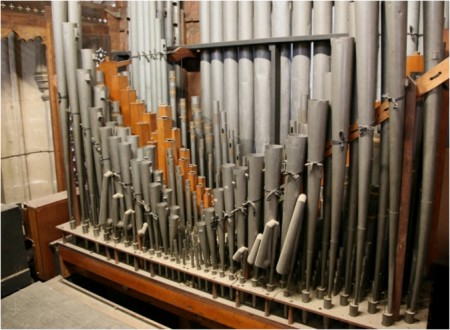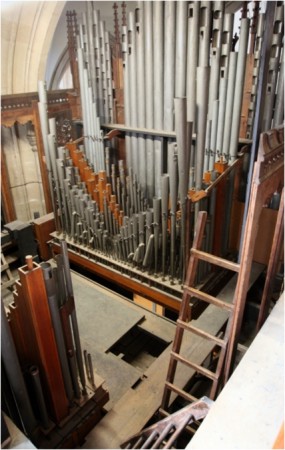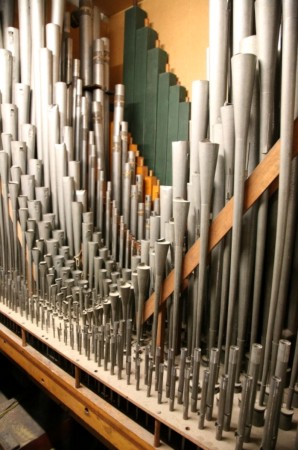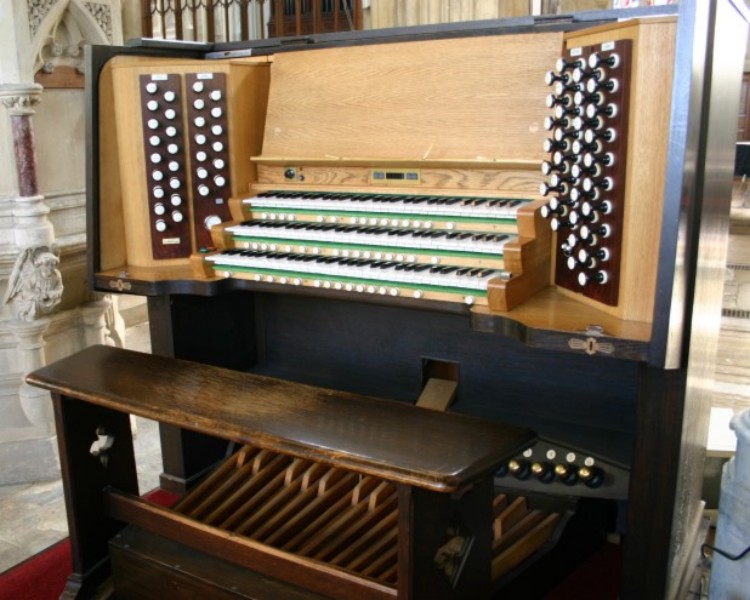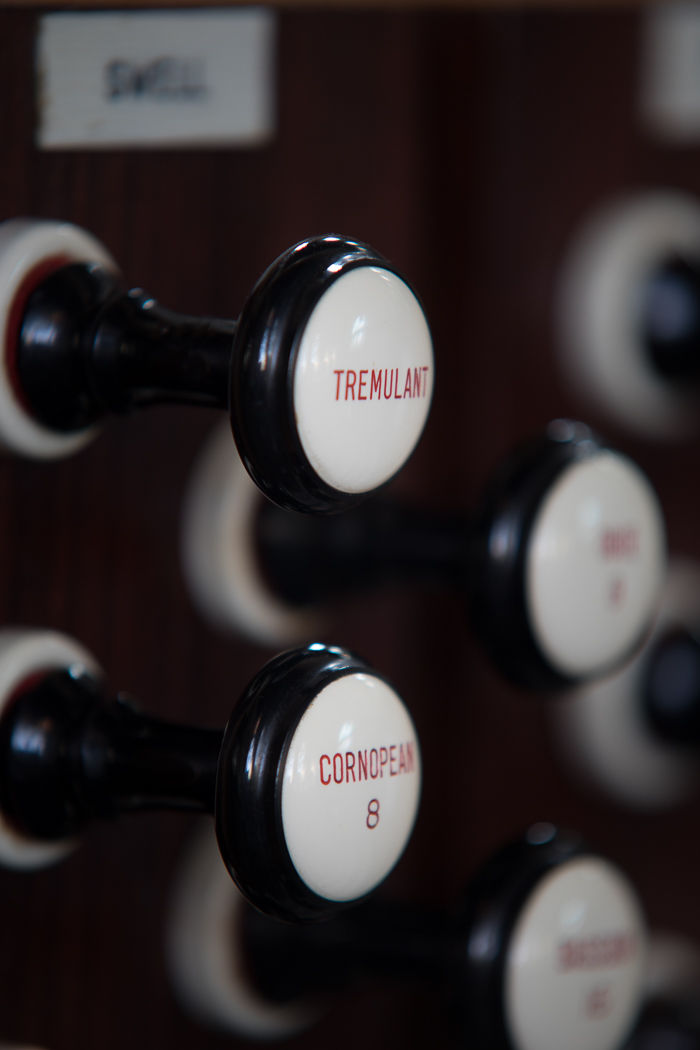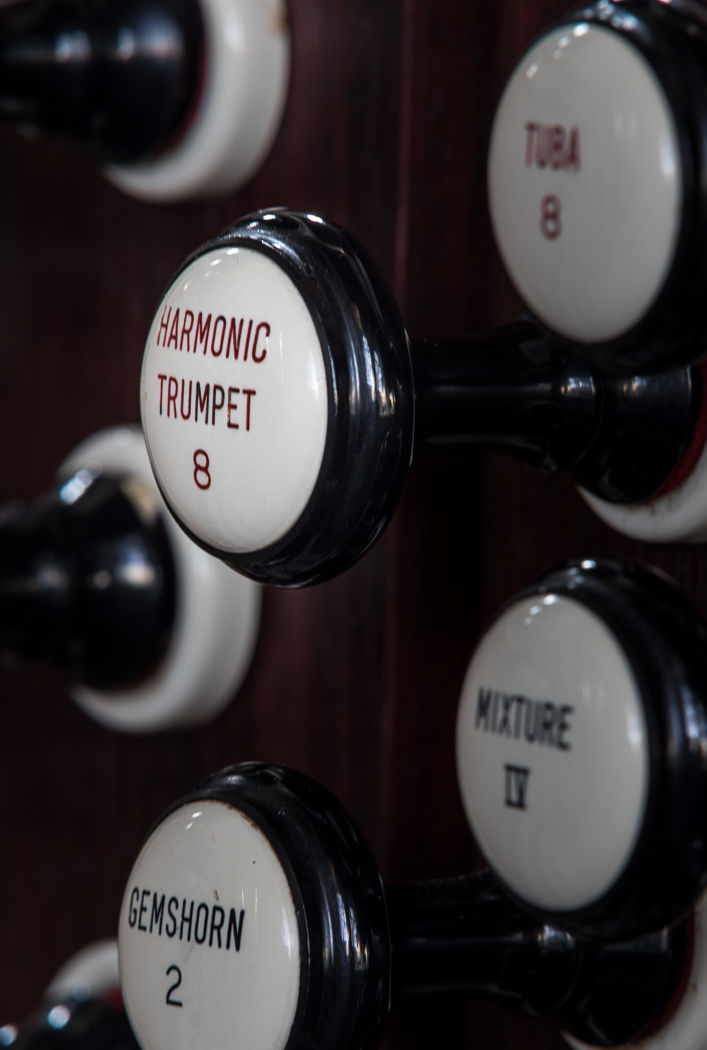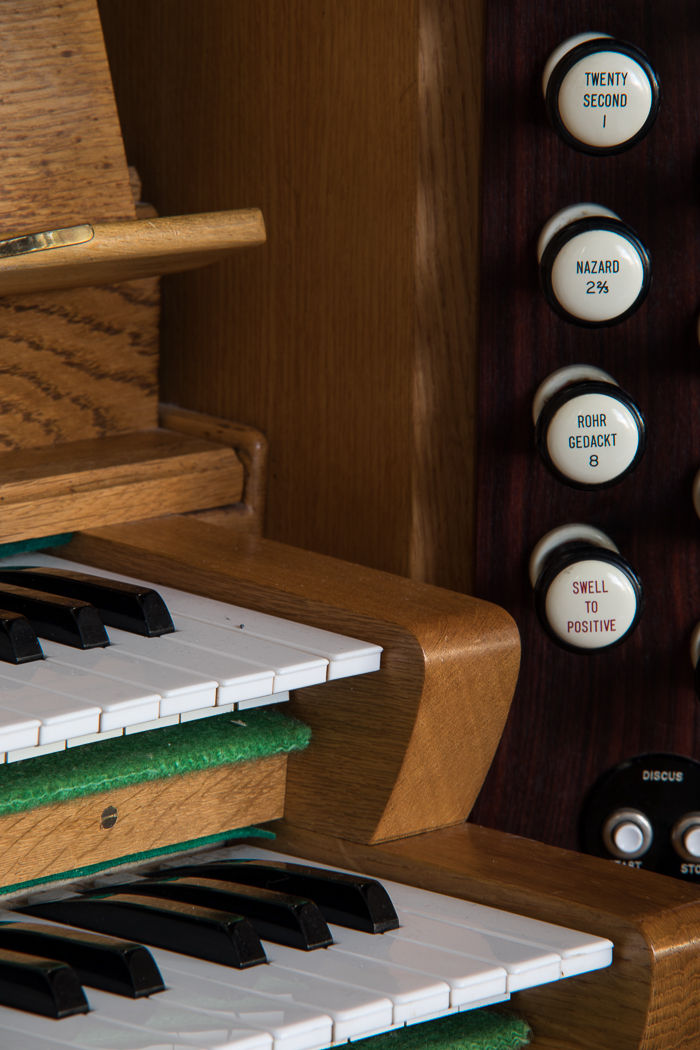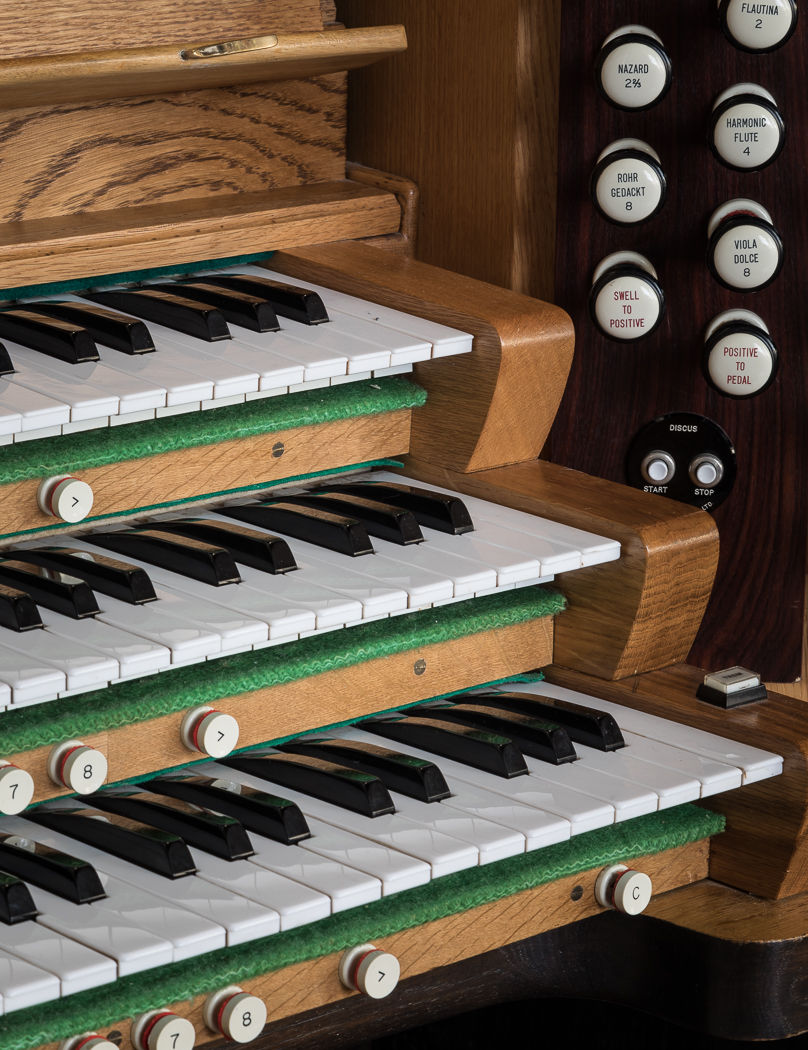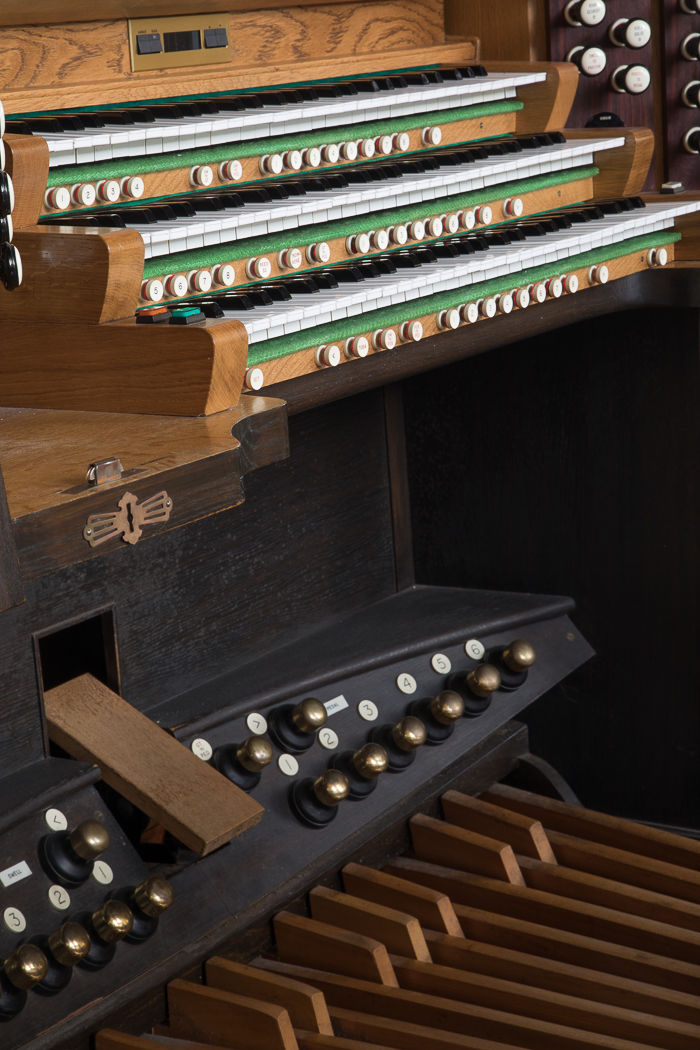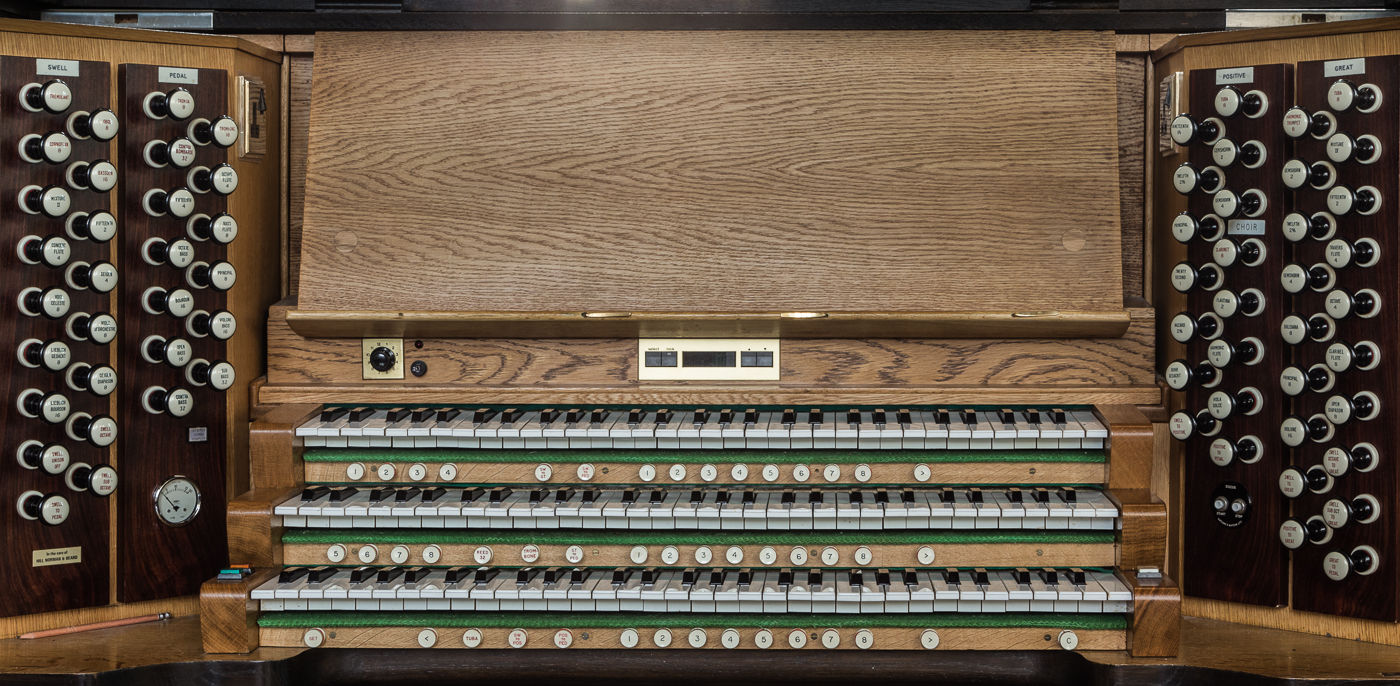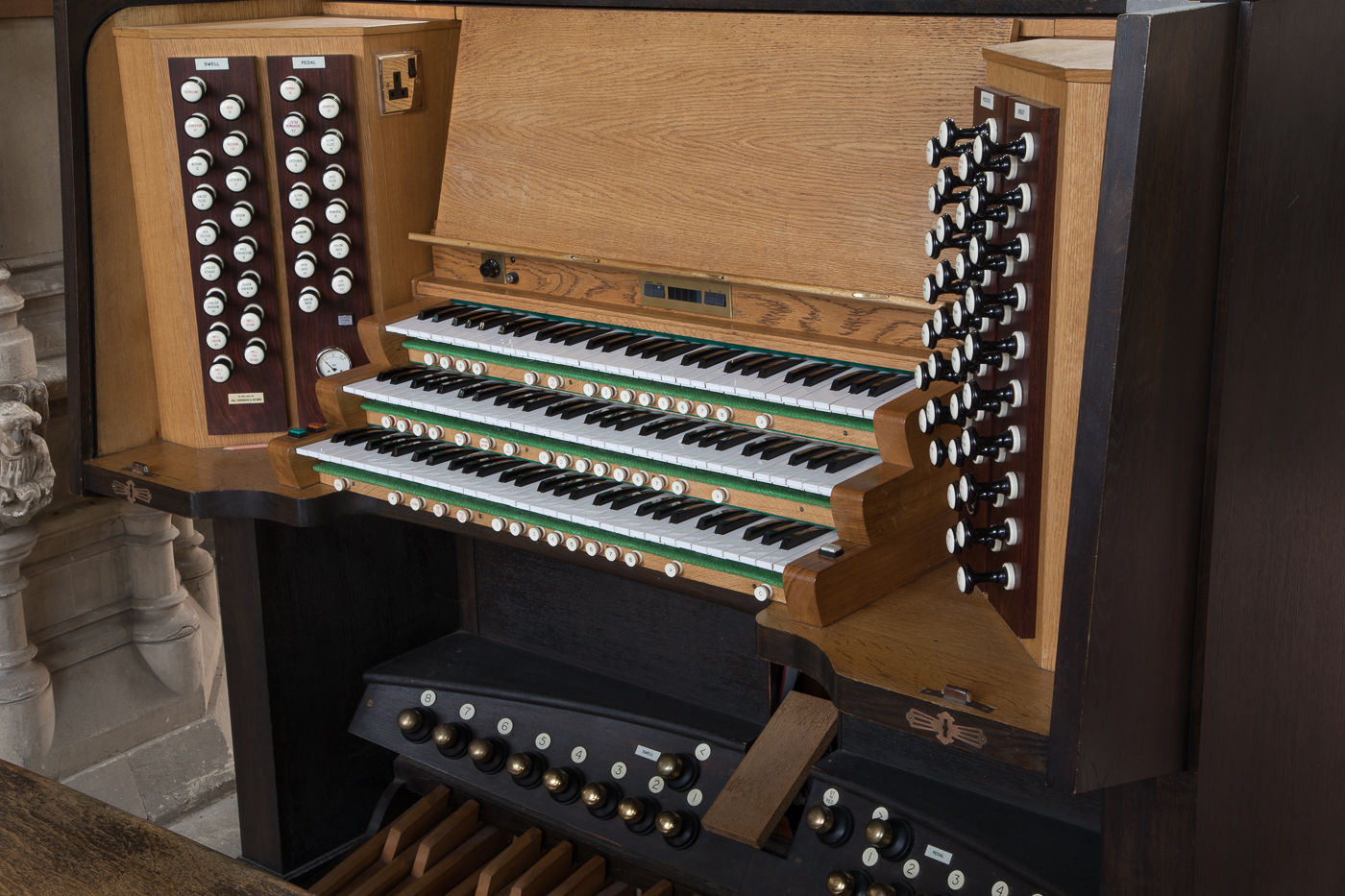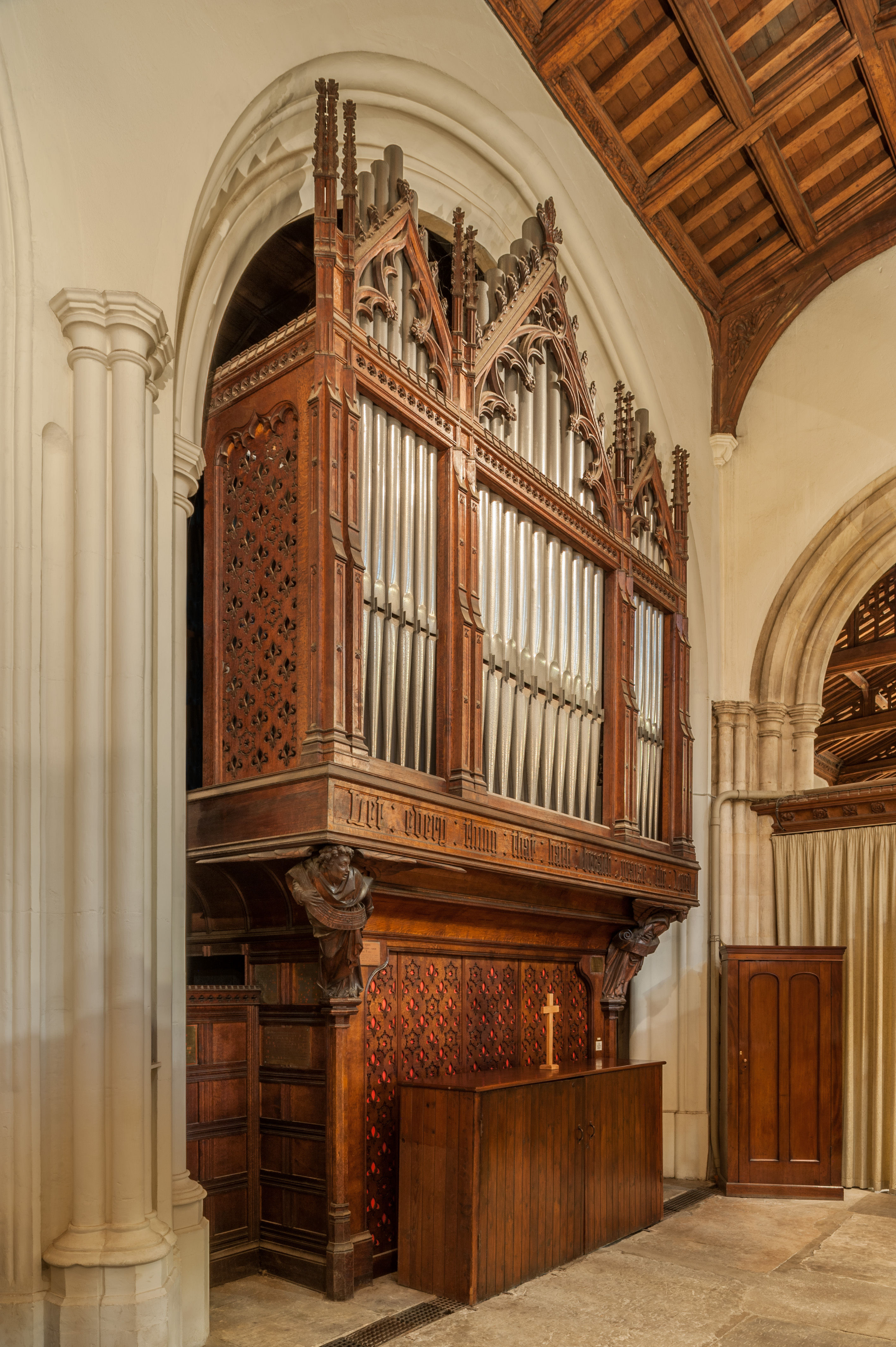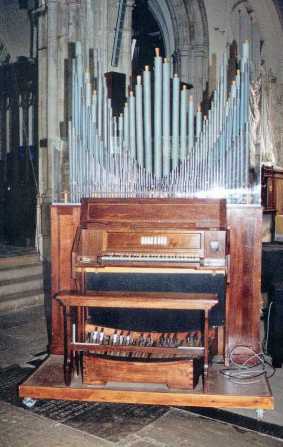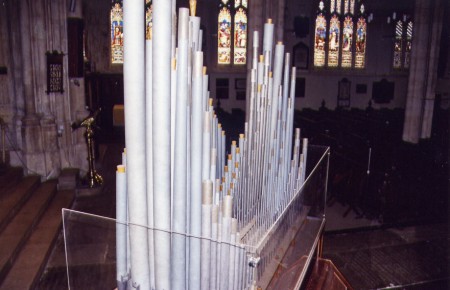A HISTORY OF THE
ORGANS
In the parish church of
All Saints Maidstone, Kent
written by
Reginald Hughes B.Mus.
Organist and Choirmaster
1970 - 1980
Up-dated 2010 by Lionel Marchant and Brian Moore
Main Organ
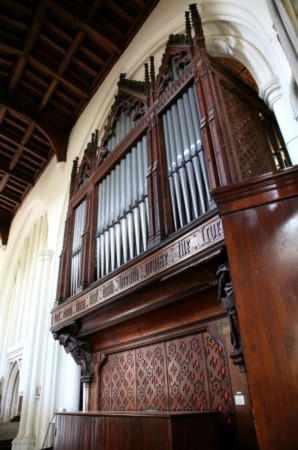 Organ case |
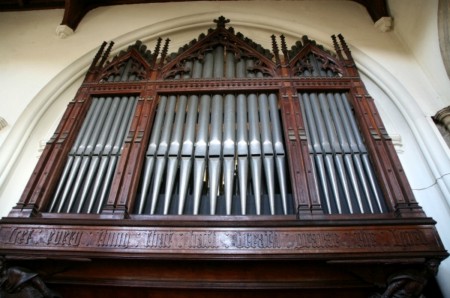 Organ case |
Almost nothing is known about early organs in All Saints’. The organ in the church was destroyed during Puritan times: there were no organists between 1594 and 1747. In December 1746 the Parish records show that:
At a meeting of the parishioners of the said Parish in Vestry pursuant to Notice legally given it was then proposed to erect an organ in the church of Maidstone to be purchased by voluntary subscription. To which proposal the said parishioners unanimously consent at the same time appointed a committee of the following gentlemen who should promote the said intended subscription and that the majority of them should have power to make and receive proposals and agree for the purchasing and erecting such organ…
The Vestry agreed that Abraham Jordan, a former London organ builder of note, should be commissioned to build the instrument. It contained 17 stops, two manuals and a pedal board, and stood in a gallery at the West End of the church across the second bay from the west wall. It was contained in a fine case surmounted by two large, gilded crowns. It further recorded that:
At a meeting of the parishioners of the parish on 5 October 1747 Mr George Launder was elected and chosen to be the Organist of the Church of Maidstone aforesaid, and that a salary of thirty pounds by the year be allowed and paid to him for his service in that capacity, provided the said George Launder shall enter into a proper security….constantly to reside in the said parish and dully to perform the above mentioned service for the space of seven years…
Mr Launder’s duties were evidently not confined to choir and organ, for in 1784 the bells received attention from Chapman and Mears, and the music of them was ‘to be left to the judgement of Mr Launder.’
Walter B Gilbert, BMus., who was organist from 1858 to 1865, was also a local historian whose book, ‘Memorials of All Saints Church, Maidstone’ was published in 1866 by Wescomb and Smith. In it he gives evidence of the meticulous care of the organ from 1750 to 1790, during which time it was cleaned and repaired every five years by Mr Jordan himself, and later by a Mr Crang (or Craing), Mr Humphrey Argent and Mr James Hancock. In 1765 Mr Crang was paid £52.17.0d for repairing and making additions to the organ.
In 1792 it was:
‘resolved unanimously that Mr Launder the Organist having at his own cost and expense undertaken to make several additions and improvements to the organ, which cannot be done without enlarging the organ gallery ... that application be immediately made for faculty’.
It would appear that this work was undertaken by Mr Hancock, organ builder, of Wych Street, London who died suddenly near Maidstone in January 1792. In the same year J Schulz was paid £50 for work to the organ during the alteration to the roof, and a further £414.10s for work to the organ. A Mr May was paid £33.7.6d which could well have been for structural alterations.
George Launder did not long enjoy the improvements for which he paid, for on 1 May 1795 there was ‘a meeting to take the sense of the Parish on the proper measures to be adopted previous to the election of a successor to Mr George Launder, deceased’.
The choice was to be confined to such candidates as were parishioners and were resident within the parish. The election took place one week later when the candidates were Mr Bartholomew Davis and Mr William Baily. A poll was demanded by the friends of the respective candidates, at the final close of which the numbers were Mr Davis 203, Mr Baily 178. The majority in favour of Mr Davis was 25 and he was thereupon duly elected. His reign was very short, for in September 1797 there was another meeting ...
... to elect an organist for this parish in the room of the late Mr Bartholomew Davis deceased.
Mr Edward Saunders being proposed by Sir William Bishop and seconded by Mr Stephen Page and no other candidate appearing he was unanimously elected.
The next development was in 1843 when, under the chairmanship of the Reverend William Vallance, Perpetual Curate, it was ‘resolved that an application be made for a faculty for the removal of the Organ and Organ Gallery in All Saints Church and for the placing of the Organ within the Arch at the southwest end of the Church, and that when obtained the Organ be repaired and improved and replaced accordingly, and the expenses attendant thereon be paid out of the Subscription to be raised for those purposes.’ The reason for the move is not clear but the work was carried out by Bishop and the organ was re-opened on Sunday 28 January 1844.
The next known organist was John Hoadly, elected in 1845. The following account from the Vestry Book explains the procedure.
‘Resolved that an Organist be elected and appointed for the Parish Church of All Saints at Maidstone at a salary of forty pounds a year to be paid out of the Church Rates to perform all the duties of Organist as he shall be from time to time directed by the Perpetual Curate of the said Church and also to teach the Children of the various Charity Schools attending the said Church Psalmody.
The above Resolution was carried after a Poll being taken when the numbers were as follows:
For the Motion 578
Against 493
Majority for 94
Resolved that John Charles Hoadly be elected and appointed Organist for the Parish Church of All Saints pursuant to the foregoing Motion –
The above Resolution was carried after a Poll being taken when the numbers were as follows:
For Mr John Charles Hoadly Jnr 709
For Mr George Easter 673
Majority for Mr Hoadley 36
William Vallance, Chairman
In 1852 William Vallance proposed the removal of the organ to a position over the vestry, which was to be raised to receive it. He informed the meeting, according to the local press, that ‘a liberal parishioner, and inhabitant of Maidstone, had communicated his desire of bearing the whole expense of removing the organ’. The newspaper commented that ‘there can be no question that the disencumbering of the body of the church of the huge, unsightly mass which now disfigures the southwest aisle will be a great improvement to the appearance of the interior, and must greatly promote the comfort of those who have the misfortune now to have seats in its vicinity.’
Strong objections were voiced, by a Mr Beale in particular, to the innovations and changes which had taken place. It was pointed out that Mr Beale did not attend at All Saints. After lengthy debate the Vestry agreed to the proposal provided that the Perpetual Curate bore the cost. Whether the ‘liberal parishioner’ was Mr Vallance himself is not known. It is understood that at this time the fine classical case vanished, to be replaced by a poor Gothic specimen.
And so to June 1879, when the Vestry was advised by Dr Frederick Bridge, Organist of Westminster Abbey, to have a new organ as the existing one was not worth repairing, although some ranks could be retained. Tenders were made by Willis, Lewis and Foster & Andrew of Hull, and Lewis was commissioned to build a new instrument for £1200.
There was much discussion about the position of the organ, and the view which prevailed was that ‘the lighter portion should be placed in the centre bay on the south side of the chancel, with the heavier portion in the existing chamber’ over the vestry.
A new case costing £350 was donated by Messrs Hollingworth of Turkey Mill, who also gave £600 for the organ itself. The case was designed by Hubert Bensted and made by Thomas Elmore, and the carvings were by Farmer & Brindley of London. This is the existing case which, whilst it may not possess exquisite beauty, is quite attractive and worthy of close examination.
The tonal specification was drawn up by Dr Bridge in consultation with Thomas Lewis, and was as follows:
Specification of the Lewis organ of 1880
| Great | Choir |
| 1 | Bourdon Wood and Metal |
16 | 22 | Lieblich Gedeckt Wood and Metal |
8 |
| 2 | Open
Diapason Metal |
8 | 23 | Salicional Metal |
8 |
| 3 | Open Diapason 2 Metal |
8 | 24 | Vox Angelica Metal |
8 |
| 4 | Claribella Wood |
8 | 25 | Flauto Traverso Metal |
4 |
| 5 | Octave Metal |
8 | 26 | Lieblich Gedeckt Metal |
4 |
| 6 | Flute Harmonique Metal |
4 | 27 | Clarionet Metal |
8 |
| 7 | Twelfth Metal |
2 2/3 | |||
| 8 | Fifteenth Metal |
2 | |||
| 9 | Mixture Metal |
4 ranks | |||
| 10 | Trumpet Metal |
8 | |||
| Swell | Pedal | ||||
| 11 | Lieblich
Gedeckt Wood and Metal |
16 | 39. | Open Bass Wood some pipes from old organ |
16 |
| 12 | Open Diapason Metal |
8 | 40. | Sub Bass Wood |
16 |
| 13 | Stopped Diapason Metal from old organ |
8 | 41. | Posaune Metal |
16 |
| 14 | Viole de Gamba Metal |
8 | |||
| 15 | Voix Celeste Metal |
8 | |||
| 16 | Principal Metal from old organ |
4 | |||
| 17 | Flautina Metal |
2 | |||
| 18 | Mixture Metal |
2 ranks | |||
| 19 | Bassoon Metal |
16 | |||
| 20 | Horn Metal |
8 | |||
| 21 | Oboe Metal |
8 |
Choir, Swell and Great to Pedal
Swell to Great, Swell to Choir
6 Combination pedals
1814 pipes
Tubular pneumatic action
All manual ranks 56 pipes; pedal ranks 30 pipes
Some items from the 1880 accounts, all of which are preserved, make interesting reading:
Dr Bridge’s fee: 20 guineas
Frank and Edmund Vaughan: Carpenter 37 hours,
Labourer 94 hours –
Charge £3.10.6d.
Dennis Paine & Co., To luncheons for 26 and attendance
High Street: £2.7.6.d
Hire of harmonium, February to May: £2.18.0d.
Royal Star Hotel Dinners
11.0d
(J Keeley, Family Hock 2.6d.
& Commercial Hotel): Champagne 10.0d
Cigars 1.0d.
Attendance
.6d
£1.5.0d.
The rate charged for a labourer was 1.3d per hour. The total cost of the organ and all attendant work and expense was £1800. A little simple arithmetic indicates the same project today would be at a prohibitive price.
The organ was opened on 14 May with a service in the morning, a recital in the afternoon and then evensong. Not everything went smoothly, for the choir of Rochester Cathedral which had been booked for the morning was unavoidably delayed on the road, and so the Vicar, Archdeacon Dealtry, gave his sermon first. Among his remarks were some that indicate some dissent regarding the position of the instrument:
‘The committee gave the most careful consideration to the position of the organ, and were aided in their deliberations by a skilled architect and also by Dr Bridge. Their decision was not called in question till the work was so far advanced that it was impossible to make any change.’ What had been done had been well done, and posterity would acquit them of any error either as regards taste or judgment.
The choir had arrived during the sermon and entered upon its conclusion. The music was Barnby’s Venite, Te Deum and Jubilate Deo, and Bridge’s ‘It is a good thing to give thanks.’ Dr Bridge gave the following programme in the afternoon:
| Introduction and Fugue | Stanley | ||
| Allegretto | Gade | ||
| Minuet and Trio | Sterndale Bennett | ||
| Prelude and Fugue in B minor | J S Bach | ||
| Andante | Mozart | ||
| Concerto No 3 | Handel | ||
| Andante in F | Merkel | ||
| March and Chorus (Ruins of Athens) | Beethoven |
The sitting of the organ continued to be a source of concern, the main objection being that the south chancel aisle was obstructed, and as soon as 1885 the decision was made to construct a chamber for the instrument. The space between the end of the south aisle and the vestry was utilised, and it would take a very keen eye to detect this later addition to the external fabric, though it is fairly obvious that the window above the south aisle alter must have been an outside one. The work was carried out at a cost of £750, for which a public appeal was made.
It seems that visual considerations outweigh musical matters, and it was probably right that they should, but it was found that the new position was acoustically very restricting, for the sound did not reach the nave at all effectively. One may assume that, having spent some £2500 within five years, those responsible felt obliged to tolerate the result until such time as the organ required further attention, and in 1909 the Vestry received a report that extensive repairs were needed.
A year later E G Meers, Esq, agreed to pay for the complete rebuilding at a cost of £1200. The work was undertaken by Rushworth & Dreaper of Liverpool, and in an attempt to overcome the problems a Mr John Whiteley increased wind pressured and revoiced much of the pipe work so as to produce a louder sound which, hopefully, would give better support to the congregation in the nave. In this he was successful, but almost certainly the quality of Lewis’ work was impaired. The specification was considerably extended, as will be seen below. The pedal department was improved, mainly be the extension principle, from 3 to 9 stops. Mr Meers is said to have been responsible for the addition of the 32 foot Sub-Bass. Mr Whiteley added a number of ranks, mainly of the string quality for which he was noted.
Specification of the Rushworth & Dreaper organ of 1911
| Great | Choir |
| 1. | Violone | 16 * | 24. | Holhflute | 8 * |
| 2. | Diapason | 8 | 25. | Viola Dolce | 8 |
| 3.. | Diapason | 8 | 26. | Unda Maris | 8 * |
| 4. | Major Flute | 8 * | 27. | Lieblich Gedeckt | 8 |
| 5. | Clarabel | 8 | 28. | Traversflote | 4 |
| 6. | Dulciana | 8 | 29. | Lieblichflote | 4 |
| 7. | Octave | 4 | 30. | Clarionet | 8 |
| 8. | Harmonic Flute | 4 | 31. | Orchestral Oboe | 8 * |
| 9. | Twelfth | 2 2/3 | |||
| 10. | Fifteenth | 2 | |||
| 11. | Mixture | 4 ranks | |||
| 12. | Harmonic Trumpet | 8 | |||
| Swell | Pedal | ||||
| 13. | Lieblich Bourdon | 16 | 32. | Sub Bass | 32 * |
| 14. | Geigen Diapason | 8 * | 33. | Open Bass | 16 |
| 15. | Gedeckt | 8 | 34. | Violone Bass | 16 * |
| 16. | Viole d'Orchestre | 8 | 35. | Bourdon Bass | 16 |
| 17. | Voiles Celestes Two ranks |
8 * | 36. | Great Bass | 16 * |
| 18. | Geigen | 4 * | 37. | Octave | 8 * |
| 19. | Flautina | 2 | 38. | Flute | 8 * |
| 20. | Mixture | 2 ranks | 39. | Trombone | 16 |
| 21. | Bassoon | 16 | 40. | Tromba | 8 * |
| 22. | Cornopean | 8 | |||
| 23. | Oboe | 8 |
Swell to Great – unison, octave
and sub-octave
Swell to Choir
Swell, Great and Choir to Pedal
Pistons and Combinations Pedals
Tubular Pneumatic action
throughout.
The probable new pipework is
indicated thus*. The pedal Octave, Flute and Tromba were extensions of
the Open Bass, Bourdon and Trombone. The Great Violone was extended to
the Pedal, and the Major Flute was an extension of the Pedal Octave.
Much of the remainder was Lewis, probably revoiced. Any further comment
would be pure speculation.
Click HERE to view a PDF file of the booklet 'Dedication and Opening of the Organ on June 17th 1911
Rebuilding the organ is a major matter causing much upheaval. Those of us who have experienced the current endeavours will appreciate the feelings expressed in the parish magazine of 1911:
The Renovation of the Organ
We have waited long for it, and
some of us may almost have forgotten it, but the crucial stage in the
renovation of our organ has at length come. Over 200 miles away, in a
Liverpool workshop, the intricate details have been carried as far as
possible to completion. Now they are about to be sent to Maidstone to
find their destiny in the parish Church. But this is to be no mere
enlargement, it is rather a re-creation. The old organ must die before
it rises again in renewed youth and beauty. For some months its voice
will be silenced in temporary dissolution. Its disordered parts will
fill the South Choir aisle, and overflow into the College Gateway
rooms. And there is worse to tell – we shall have an
organ less
Easter. Not till we are approaching the Month of May is there any
promise of our organ being restored to us. But why look so concerned?
Will you not enjoy your feats all the better for being hungry? It, as
we are led to hope, our organ will be surpassingly exquisite in its
tones, we shall be amply repaid for a little patience. After all the
early Christians offered some very beautiful and very acceptable worship
without any musical accompaniment but the joyful psalmody of melodious
hearts, and the dreary echoes of the catacombs. Besides, we can trust
our choir to rise to the occasion, and perhaps it is not beyond hope
that the congregation will prove itself vocally strong and of good
courage. Therefore we can look forward without anxiety to a short
regime of the harmonium, dating from the 3rd Sunday of this
month, supported by a sense of confidence in our own adaptability, and
by the pleasurable anticipation of better things to come.
Since 1911 little has been done to the organ. In 1912, after endless debate, a new blower was installed, thanks to the generosity of an anonymous donor. In memory of the revered Frank Wilson Parish, Organist for 50 years, a Tuba was added in 1952 playable from the Great and Choir. Otherwise, in spite of various alarms, the instrument functioned incredibly well until it was dismantled in 1979. Indeed there were problems, and the specification imposed severe limitations on the performance of modern music, but immense tribute must be paid to the workmanship which created a worthy organ to function for no less than 68 years. For the past twenty years a succession of organists, including the author, has prophesied doom and gloom. In 1960 A Langmead Robinson submitted a comprehensive report which enumerated the faults and deficiencies, and all of it was true, yet twenty years later the monster continued to growl very reliably.
In tackling the question of the present rebuild the Committee had three main objectives, which were to provide an organ befitting the principal parish church of Maidstone and appropriate to the needs of its worship, to improve its tonal specification so as to make it attractive to eminent recitalists; and to consider its position and effectiveness.
Deliberations were exacerbated some years ago by oft-repeated opinions that the existing organ was in such a state that it was not worth rebuilding. The possibility of acquiring a good instrument from a redundant church was fully explored, and the fine organ from Holy Trinity was removed and stored in All Saints for two years with a view to erecting it, but there was no money and eventually it was sold. Organs in Birmingham and Southend were examined and considered most carefully, but were ultimately dismissed when A Foster Waite, an organ builder from Newbury, expressed the view that our own was well worth preserving.
The possibility of a site more acoustically favourable was explored, and for a considerable period the choir was placed at the west end, working with a small organ provided by Martin Renshaw, a Kent organ builder, who also set up a portable organ in the chancel. This was a very satisfactory arrangement musically but general opinion that the choir should be seen as well as heard prevailed, and the removal of the chancel screen settled the matter: the choir should be in the chancel. Although all the experts agreed that the best place for an organ was at the west end, it was clear that in so large a church the organ and choir cannot be at opposite ends of the building. An equally telling objection was the cost involved in moving the organ to a new position. Even though a small instrument would suffice, the additional expense of a new frame and case, as well as blowing equipment, would have run to several thousands of pounds. As has been seen throughout this brief history, the position of the organ raises immense difficulties musically, visual and financially and the present solution is, like all the others, something of a compromise.
To digress briefly, in early 1979 a group from All Saints visited Folkestone Parish Church to see and hear the electronic instrument built there by Copeman Hart. In may ways this was very impressive, and Mr Hart was invited to come and to put forward a scheme. His proposals were given most careful thought, and a second trip to Folkestone took place. The organist came to the conclusion that such a step was not for Maidstone, and was able to convince the Vicar and others that it was unthinkable to install a synthetic instrument when we already had resources worth a great deal of money in our possession.
So the decision was made to rebuild the existing organ in its present position with whatever improvements could be afforded. Michael Fleming, the Diocesan Organ Adviser, came down and gave approval to a scheme proposed by Messrs. Wood Brown Ltd of Maidstone, the main elements of which were:-
1. Complete cleaning and overhaul and
replacing the old tubular pneumatic action with electro-magnetic.
2. Removing the Choir box and the Great Bass and renewing the Swell box
shutters so as to allow more effective passage of sound.
3. Providing new pipework outside the chamber to bring sound closer to
the nave.
4. Installing a new console, detached and placed closer to the chancel,
enabling the player better to hear the choir.
5. Deleting certain less attractive and useful ranks and adding new
stops to give added brightness and penetration.
Specification of the rebuilt organ by Wood-Brown, 1980
| Great | Choir |
| 1. | Violone | 16 | 27. | Rohr Gedeckt | 8 |
| 2. | Open Diapason | 8 | 28. | Viola Dolce | 8 |
| 3.. | Principal | 8 * | 29. | Harmonic Flute | 4 |
| 4. | Dulciana | 8 | 30. | Lieblich Flute | 4 |
| 5. | Claribel Flute | 8 | 31. | Flautina | 2 * |
| 6. | Octave | 4 | 32. | Cor Anglais | 8 * |
| 7. | Traverse Flute | 4 | 33. | Clarinet | 8 |
| 8. | Gemshorn | 4 * | 34. | Tuba | 8 |
| 9. | Twelfth | 2 2/3 | |||
| 10. | Fifteenth | 2 | Positive | ||
| 11. | Gemshorn | 2 * | 35. | Principal | 8 * |
| 12. | Mixture | 4 ranks | 36. | Gemshorn | 4 * |
| 13. | Harmonic Trumpet | 8 | 37. | Gemshorn | 2 * |
| 14. | Tuba | 8 | 38. | Twelfth | 2 2/3 * |
| Great to Pedal | 39 | Nineteenth | 1 1/3 * | ||
| Swell to Great | Tremulant | ||||
| Swell to Great Octave | Choir/Positive to Pedal |
||||
| Swell to Great Sub Octave | Swell to Choir/Positive | ||||
| Choir/Positive to Great | |||||
| Swell | Pedal | ||||
| 15. | Lieblich Bourdon | 16 | 39. | Sub Bass | 32 |
| 16. | Geigen Diapason | 8 | 40. | Open Bass | 16 |
| 17. | Lieblich Gedeckt | 8 ** | 41. | Violone Bass | 16 |
| 18. | Viole d'Orchestre | 8 | 42. | Bourdon | 16 |
| 19. | Voix Celeste | 8 | 43. | Bass Flute | 8 |
| 20. | Geigen | 4 | 44. | Octave Bass | 8 |
| 21. | Concert Flute | 4 ** | 45. | Principal | 8 |
| 22. | Mixture | 2 ranks | 46. | Fifteenth | 4 |
| 23. | Fifteenth | 2 ** | 47. | Octave Flute | 4 |
| 24. | Bassoon | 16 | 48. | Trombone | 16 |
| 25. | Cornopean | 8 | 49. | Tromba | 8 |
| 26. | Oboe | 8 | Great and Pedal Pistons couples | ||
| Tremulant | |||||
| Octave | |||||
| Sub Octave | |||||
| Unison Off | |||||
| Swell to Pedal |
** Indicates new
stops or redeployment
Manual
Compass CC – A Pedal Compass
CCC-F
Detached all
electric drawstop console with five adjustable Pistons to Great, Swell
and pedal and four to Positive.
Reverser Pistons to Great to Pedal and Swell to Great.
General Cancel Piston.
Notes:
Nos 3, 8, 11, 28, 33 and 35 are all drawn from the new Gemshorn unit placed above the south aisle altar.
No 2 is the softer of the original two Diapasons. The other has been utilised to give Nos 45 and 46.
No 19 is now one rank to allow the addition of No 21.
No 34 has been transferred from the Swell. No 36 is the old Orchestral Oboe revoiced.
Stops which have been deleted are:
Great Major Flute and large Open Diapason
Choir Hohl Flute and Unda Maris
Pedal Great Bass
It is possible that No 2 is pipework from the pre-1880 organ but this is only speculation. It is possible also that the following are Lewis ranks:
Nos 5, 6, 9, 10.12, 13, 15, 18, 19, 22, 24, 25, 26, 27, 31, 32, 34, 37, 40, 42, 47.
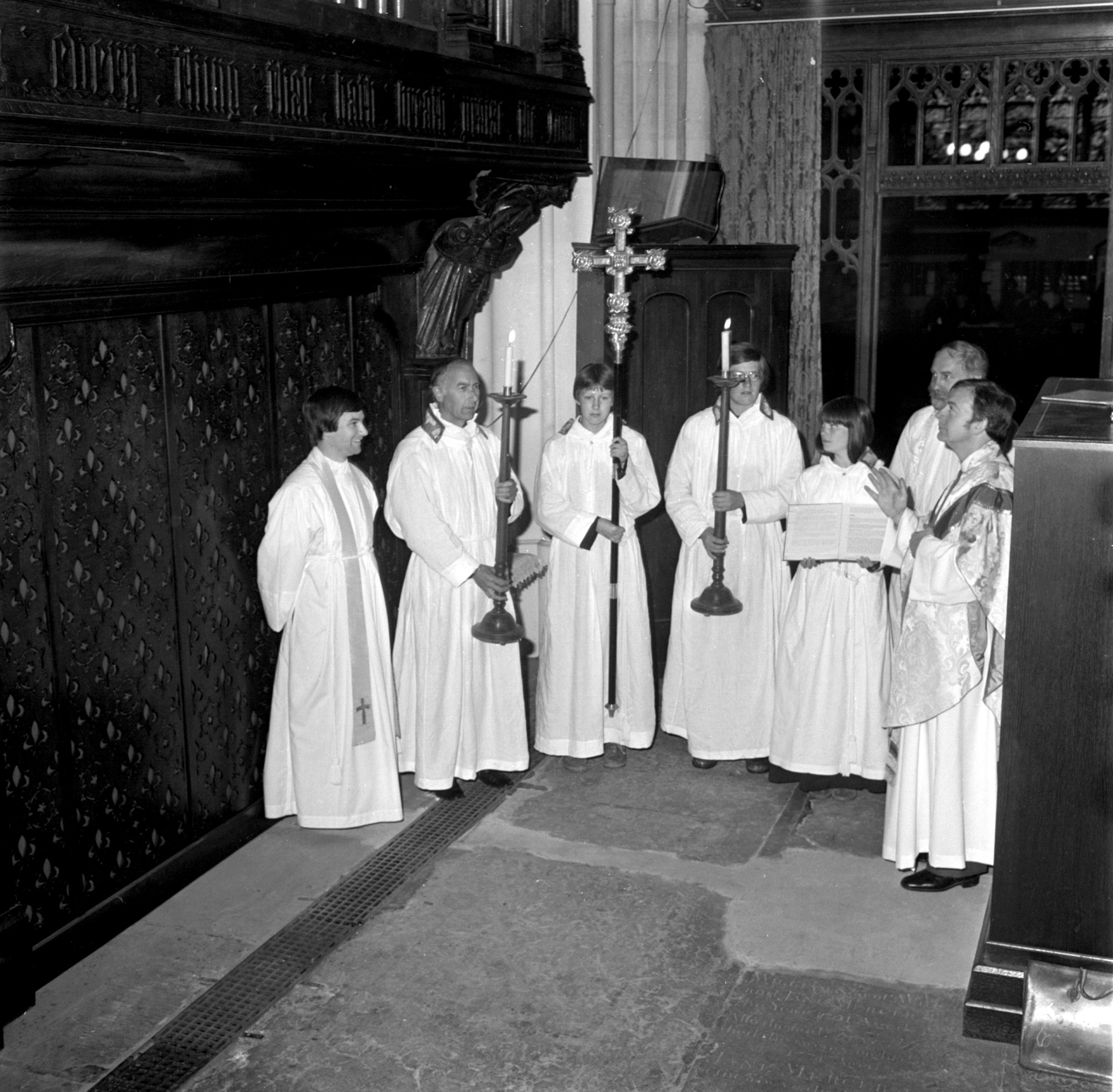
Rededication of the organ by the vicar The Revd. Canon Peter Naylor Sunday May 11th 1980
|
Working to a limited budget the Committee has endeavoured to preserve the best of what there was and to improve tonal capabilities for both services and recitals. The greater part of the expense has been met by the proceeds of generous legacies and a substantial gift from the Restoration Fund. There have also been a large number of donations. Thanks are due to all who have supported this important undertaking with their gifts, their interest and encouragement and their effort.
In 1985 the care of the organ was transferred from Wood Brown to Hill Norman & Beard and discussion immediately began to cure the unstable wind supply to the new Gemshorn unit. This unit had lived up to its expectations in providing a clear lead to congregational singing being placed in a position outside of the main organ case, speaking directly into the Nave. However the unstable wind supply often resulted in a “tremulant” effect with the result that the unit was often not used. This was cured in 1986 by the provision of a concussion unit.
It was felt to be convenient for the player to separate the stops described as “Positive”” between “Choir” and “Positive”. To enable this two push button switches labelled “Choir on/off” were installed to the left of the “Positive” keyboard. This had the effect of making the new Gemshorn unit the “Positive” and the remaining stops
(the original “Choir” organ) became once again the “Choir” organ. The Tremulant stop knob (XI) was also removed and replaced by a reversible push button to the right of the Positive/Choir keyboard.
The Lieblich Flute (number 32) was replaced in 1987 by a Nazard 2 2/3 and the Cor Anglais (number 37) was replaced by a Twentysecond 1’. Both of these changes were made to add brightness to the organ and have been used to great effect.
In 1989 an electronics expert in All Saints congregation offered to construct a Contra Bass 32’ in support of the existing Sub Bass (number 40)
Part of the main bellows needed repair in January 1991 and in October 1991 the Swell strings (numbers 18 and 19) were revoiced to give a much softer sound. At the same time the motors of the swell top note machine were releathered.
An electronic 32’ Contra Bombarde was supplied and installed by Organ Supplies and Services in 1993 and tuned to compliment the Trombone (number 49).
With the demise of Hill Norman & Beard the care of the organ was transferred to Colin K Jilks & Associated Limited. This was not such a major change as might at first be thought as Colin Jilks had been tuner for the organ with both Rushworth & Dreaper and Hill Norman & Beard.
The complete re-wiring of the console, pistons and transmission, together with a full solid state coupler system in the organ (completely replacing the 1980 electric stop and coupler switching) was undertaken during May 2007. The console was installed on a moveable platform at the north east end of the nave just in front of the pulpit. This gave the organist the opportunity to see and hear what was taking place during services and at recitals the audience were able to see the player when the console was moved to the centre of the nave.
The organ remains in good condition and receives a ‘quinnquennial’ report from our organ builder so that any approaching problems can be identified early.
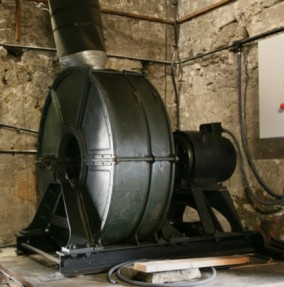 The 1912 blower |
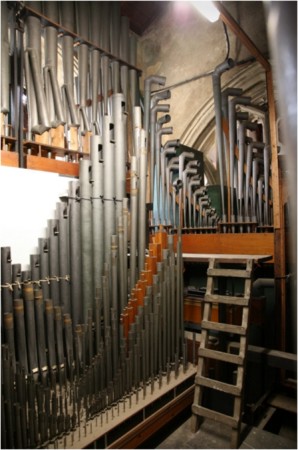 The Choir Organ with the Tuba in the background |
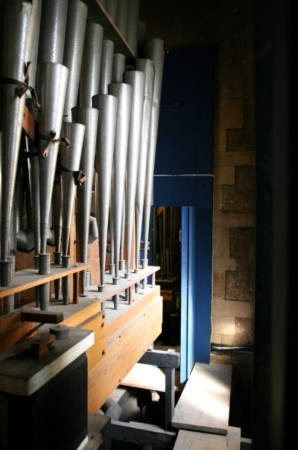 The Pedal Reed |
The current specification of the organ (January 2010) is now:-
